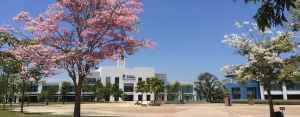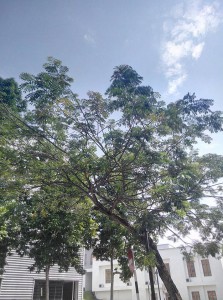August 25, 2015, by sustainablenottingham
Green UNMC – meet our varied and wonderful trees
Pei Sze Teh shares her experience of a summer internship at UNMC.
After my 3rd year of studying chemical engineering at UNMC I applied for the campus summer Internship Programme, was successful and placed with Environment Committee to start up a flora and fauna survey. The idea of the project is to catalogue all flora and fauna on campus, and tell people about it, in case they had failed to notice how green our campus has become in the 10 years since it opened its gates. My main task was to identify and count all the trees and shrubs. I divided the campus into small sections and carried out walk-overs one section at a time.
I spent my whole summer counting trees. There are 2242 trees on campus belonging to 56 different species. I will introduce three here – the most numerous tree, the most useful and the most photographed.
The most common tree species on campus is oil palm (Elaeis guineensis) – 724 trees. Hardly surprising, as before becoming The University of Nottingham Malaysia Campus (UNMC), the land was an oil palm estate.
The Environment Committee and SA Nature club are working on replacing the aging oil palm trees with other species of tree to increase the biodiversity of the flora and fauna on campus. Greater diversity of plants attracts a greater variety of insects, birds, reptiles and mammals. Besides, some environmentalists suspect that oil palms produce unusually high levels of volatile organic compounds. These react with nitrogen oxides, available from the unfortunately high volume of traffic on campus, in the presence of sunlight to form ozone. While ozone is welcome high in the atmosphere shielding the Earth from damaging ultraviolet light, at ground level it causes breathing problems and damages plants.
Oil palms are not indigenous to Malaysia, but native to West Africa and Central and South America. They were introduced for commercial vegetable oil production. The United Nations Environment Programme has announced that palm oil plantations are now the leading cause of rainforest destruction in Malaysia and Indonesia. Maybe oil palms are not the image a green campus should project.
Samanea saman is the second most numerous species on campus. Native to Latin America, from Nicaragua to Brazil but particularly Venezuela, S. saman has the ability to fix atmospheric nitrogen. That makes it an excellent tree to start up greening an area by providing nitrogen for other plants. Trees have been shown to nodulate effectively in Hawaii, Malaysia and the Philippines with a wide range of strains of Rhizobium.
Finally, a very prominent and well-loved tree is Tabebuia heterophylla, which requires a distinct dry season in order to burst into bloom. The trees are often found in the more seasonal parts of Malaysia, and have proudly been called the “Cherry Blossoms of Penang” because of the pink Tabebuia flowers. They are very similar to the world famous cherry blossoms of Japan with their short and intense flowering season, and pretty soft petals. Flowers are large, in various tones of pink to purple or white, and appear while the tree has no, or very few, leaves. While there is no historic connection or practical use, Tabebuia flowering season brings many students and staff out into the plaza to have their photo taken with the stunningly beautiful tree.
The internship is coming to an end and will leave the legacy of a full record of trees on campus in 2015. In terms of tree numbers and diversity, future surveys will be able to determine if by this one measure the campus has become greener. Thus we at UNMC are one small step closer to measuring the sustainability of our campus, which we hopefully will be able to use without compromising its developing flora and fauna.

Tabebuia heterophylla, with its attractive flowers, has been planted in the central plaza and around the lake



Hi, I’m a fellow UNMC student. I recently got obsessed with identifying insects and plants. Do you happen to have the list of tree species on campus still? I know it has been 3 years but I thought i could still leave a mesage
Hi Ed,
Thanks for getting in touch. We’ll forward your query to colleagues who were involved in the project.